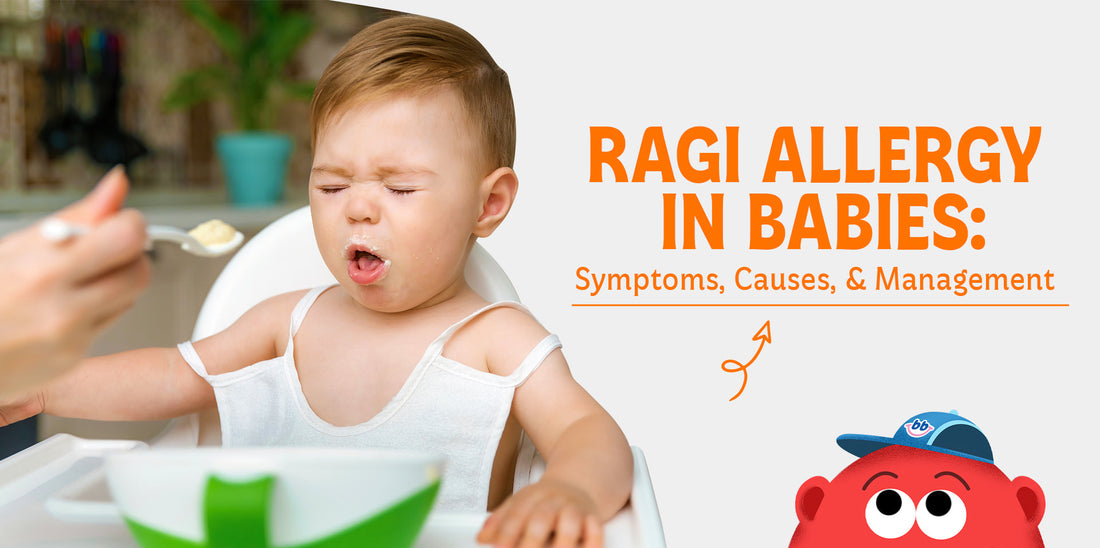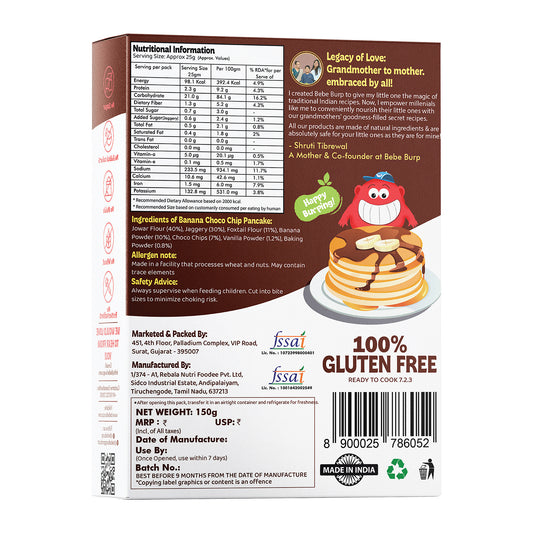Suppose your baby seems to suffer from itching, swelling, or stomach upset after eating ragi, commonly known as finger millet. In that case, they may have an allergic reaction to this ubiquitous weaning food.
Ragi allergy in infants is somewhat uncommon, and the threshold for immediate attention is between mild and very serious cases.
The following is a guide for parents, which includes essential information regarding the symptoms of ragi allergy, the causes of ragi allergy in babies, and effective management strategies for ensuring health and security when introducing this healthy grain to the child.
Understanding Ragi Allergy in Babies
Finger millet (Ragi) is a healthy grain that babies are mainly introduced to with their weaning foods.
Although ragi is healthy for the most part, some infants have a ragi allergy.
The baby's immune system mistakenly views the protein of ragi as foreign bodies, and an allergic reaction occurs as a result of which the immune system attacks.
Very few babies are allergic to ragi as compared to other allergies like cow's milk, eggs, and peanuts.
As with any introduction of new food into your child's diet, the parents should be very careful and keep a check for any bad reactions if you are planning to introduce ragi into your baby's diet.
Does Ragi Cause Allergy

Ragi itself doesn’t cause allergy, but like any food it can trigger an allergic reaction in some individuals.
The chances of ragi causing an allergy in babies is low but not zero.
Research says ragi contains some proteins that can act as allergens for some babies.
These proteins can trigger the immune system to release histamines and other chemicals, resulting in allergic symptoms.
Remember ragi is generally safe and nutritious, but every baby’s immune system is unique. What might be harmless for one baby can be a problem for another.
Allergies in Babies: What Parents Should Know
 Food allergies in infants have been an increasing trend over the years, so parents need to know about some allergens and what reactions could be identified with them.
Food allergies in infants have been an increasing trend over the years, so parents need to know about some allergens and what reactions could be identified with them.
Baby Allergens–Common Sources
- Cow's milk
- Eggs
- Peanuts
- Tree nuts
- Soys
- Wheat
- Fish and shellfish
- Sesame
- Some more than ragi (in case)
When Do Allergies Typically Develop?
Many food allergies develop in early childhood (when new foods are being introduced during weaning, ~4-6 months of age)
Genetic Predisposition
Babies with family history of other allergies (rashes, asthma), eczema are at risk of having an allergy to at least one food, which includes ragi as well.
Symptoms of Ragi Allergy in Babies

Early identification of the symptoms for ragi allergy is very much necessary so that early intervention can be taken.
The side effects may be mild and may occur from a few minutes to a few hours after taking.
Immediate Symptoms
- Skin reactions: hives, rash, or eczema flare-ups
- Abdominal issues: Vomiting and diarrhea together with stomach cramps
- Respiratory issues: such as wheezing, coughing a runny nose
- Other answers: swelling of the lips, tongue, or face (or oral)
Delayed Symptoms
- Prolonged gastrointestinal issues
- Poor weight gain/loss
- Chronic eczema
- Rec recurrent infections
Diagnosing Ragi Allergy in Babies

For the proper management of ragi allergy, diagnosing it correctly is very important so that one does not go for false dietary restrictions.
Elimination Diet
Remove ragi from the baby's diet for a while to find out if symptoms subside (Baby can be prescribed by the healthcare provider)
Skin Prick Test
It is when you take a very small sliver of ragi extract and prick the baby with it for the material to get inside the epidermis. If a wheal (dew drop) comes out, it could mean an allergy.
Blood Tests
Measures include specific antibodies (IgE) against the ragi proteins to the baby.
Food Challenge Test
The baby is monitored in an outpatient setting as the baby is fed a very small amount of ragi.
Managing Ragi Allergy in Babies

Effective management strategies, once your baby has confirmed ragi allergy, will ensure that she stays safe and healthy.
Complete Avoidance
The best management is to remove ragi from the diet of your baby.
Reading Labels Carefully
Ragi or finger millet is present in many food items-marked Ragidi (items containing ragi) are available in the food section like baby foods, cereals, etc.
Alternative Nutritional Sources
Give your baby other iron rich foods such as fortified cereals (infant), puree of meats or spinach.
Emergency Preparedness
If your child has had a past serious allergic reaction, your doctor may prescribe an EpiPen (epinephrine auto-injector) to be used in an emergency.
Prevention Strategies for Ragi Allergy

Although food allergies can't always be avoided, there are methods to restrict risk.
Gradual Introduction
Start introducing new foods 1 at a time, with space of a few days in between each to see if reactions occur.
Breastfeeding Benefits
It has been proven that high breastfeeding for at least the 1st year lessens the chance of getting food allergies.
Early Introduction Controversy
Newer studies appeared to suggest that feeding allergenic agents early (in supervised care) could prevent allergies, which is something parents should talk about with their pediatrician.
When to Seek Medical Advice for Ragi Allergy

Call your healthcare provider if your baby has ragi and the following symptoms will be shown by you immediately after feeding.
- Difficulty breathing
- Facial, Tongue and throat swelling
- Severe vomiting or diarrhea
- Lethargy or other behaviour
Conclusion
Ragi is a perfect grain for babies but must be careful of allergic reactions that can come with introducing new foods.
Through awareness of the symptomatology, causes and treatment of ragi allergy parents can empower parents to decide what food to introduce to their baby.
If your baby has a history of allergies or other health issues, always check with your paediatrician before being introduced to new foods.







